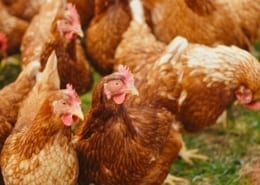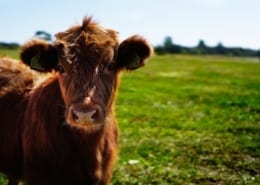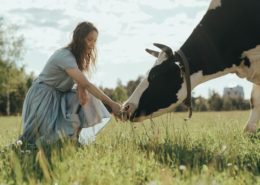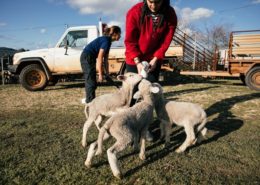Cattle farmers today collectively run over 28 million animals over 200 million hectares, and the industry has changed a great deal over recent decades. And although quality beef continues to be in high demand, the ways cattle are raised and marketed is continually evolving.
The Certificate of Beef Cattle is a professional development course that will give you insights into how to start your own beef cattle enterprise, or expand your knowledge and improve your farm operations as a beef cattle producer.
In this cattle farming course, you will learn about the role of beef cattle in agriculture, beef cattle breeds and production systems, and beef cattle diseases, nutrition and breeding.
You will also study commercial herd, feed lot and stud herd management, and marketing and economics in the beef cattle industry.
On completion of this course, you will understand the principles and practices of beef cattle husbandry, and be able to make informed decisions about the management requirements of beef cattle.
Course Structure
Unit - Beef Cattle
Unit 1 – Introduction to Beef Cattle and Beef Cattle Breeds
- The role of beef cattle in agriculture
- Scientific classification
- Examples of breeds worldwide
- British Beef breeds – Angus, Hereford, South Devon, Sussex, Red Poll
- U.S. Developed Beef breeds – Santa Gertrudis, American Brahman, Amerifax, Beefmaster
- Eurpean Beef breeds – Salers, Charolais, Simmental, Gelbvieh
- Australian Beef breeds – Braford, Beefmaster, Droughtmaster, Murray Grey, Australian Lowline
- South African Beef Breeds – Salorn, Tswana, Tuli, Africkander,
- Breed selection considerations – horned vs poll, colour, gestation length, birth weight, mothering ability, post weaning growth, meat quality etc
Unit 2 – Beef Cattle Production Systems
- Various systems of production – extensive, intensive, semi-intensive
- Choosing a suitable system – considerations include size, climate, soils, transport, markets etc
- Cattle handling facilities
- Materials used in cattle handling
- Cattle identification – branding, ear marking, tattooing, ear tags
- De-horning – chemical and mechanical methods
- Castration, dips and dipping, and injecting cattle
Unit 3 – Beef Cattle Breeding
- Heritability, performance testing, progeny testing, selection
- Pure versus cross breeding – advantages and disadvantages
- Calving percentage
- Management factors to improve calving percentage
- Weaning calves
- Factors affecting calf weaning
- The anatomy of the male reproductive system
- The physiology of the male reproductive system
- Fertility problems in the male
- The anatomy and physiology of the female reproductive system
- Fertility problems
- Pregnancy and partition
- The structure of the mammary glands
- Secretion of milk
- Growth and development
- Post natal growth
- Compensatory growth
Unit 4 – Diseases in Beef Cattle – Viral and Bacterial
- Determining health status of the animal
- Signs of a healthy animal
- Causes of ill-health
- Injury, poor nutrition, poisoning, parasites, hereditary conditions etc
- Preventing ill-health
- Correct feed and nutrition, insect control, parasite control, vaccinations, control stress etc
Unit 5 – Parasitic and Other Diseases in Beef Cattle
- Some parasitic diseases
- Other ailments of cattle – actinobacillosis, anaplasmosis, arthritis, beef measles
- poisoning, pink eye, milk fever, bloat etc
Unit 6 – Nutrition in Beef Cattle
- Feed type – roughages and concentrates
- Carbohydrates, protein, fats
- Grass or grain feeding
- Rations for beef cattle – maintenance or production rations
- Maintenance rations
- Procedure for calculating a ration
- Supplementary feeding of protein
- Lot Feeding
- Minerals
- Common macromineral deficiencies
- Common trace mineral deficiencies
- Diagnosis of trace mineral deficiencies
- Vitamins
- Water for farm animals
- Protein
Unit 7 – Commercial Herd Management
- The breeding herd
- Production systems
- Cow-calf herd
- Beef production systems using dairy stock
Unit 8 – Feed Lot Management
- Lot feeding – types of feedlot
- Managing cattle in a feedlot
- Feedlot Records
- Article on pen feeding in South Africa
Unit 9 – Stud Herd Management
- Time of calving
- Feeding
- Fertility
- Indicators of fertility in bulls
- Indicators of fertility in cows
Unit 10 – Management, Economics and Marketing
- Profitability
- Factors affecting gross output
- Factors affecting variable costs
Study Hours
Estimated duration 50 hours
Course Delivery and Start
Start anytime, self-paced and 100% online
Assessment
Assessment will be comprised of written exercises, including short-answer questions, reflective tasks, short reports and/or projects. There are no examinations or due dates for assessment. As a result, you can complete training in your own time and at your own pace with the assistance of unlimited tutor support.
Testimonials
Challenging and nice experience
V. Chen, Canterbury, VIC | Certificate of Beef Cattle
I love how easy it is to navigate the sources and they offer amazing courses!
K. McCarthy, Mareeba, QLD | Certificate of Beef Cattle
Tutors were amazing at answering my questions. I enjoyed this course.
Belinda | Devonport, TAS | Certificate of Beef Cattle
Graduation
A Certificate of Attainment and Statement of Results will be issued upon successful completion of this course.
How to Enrol
Enrol Online: Enrol Now
Enrol via Live Chat (Business Hours)
Enrol via Telephone 1300 76 2221 (Business Hours)
Enrol via Purchase Order/Tax Invoice
Enrolling Multiple Staff?
To enrol multiple staff, please complete the Employer Enrolment Form. We’ll be in touch within 60 minutes during business hours!
Payment Options
Visa, Mastercard, BPAY and Direct Deposit.
Course FAQs
Why Choose Australian Online Courses?
- Professional development that is widely recognised and respected;
- Improve your employment opportunities;
- Study online, anywhere via our elearning system;
- High-quality professional development programs written by industry experts;
- All course materials provided online – no textbooks to buy;
- Unlimited tutor support via email;
- We offer twelve (12) months’ access, with extensions available upon application (fees apply);
- Course may be tax deductible; see your tax advisor.
Are there any entry requirements or pre-requisites?
To study online with Australian Online Courses you will need a computer (desktop PC/laptop) running a current/updated operating system with reliable high-speed internet access. You will need to use the Google Chrome browser to access your course.
Are there any computer requirements?
To study online with Australian Online Courses you will need a computer (desktop PC/laptop) running a current/updated operating system with reliable high-speed internet access. You will need to use the Google Chrome browser to access your course.
When can I start this course?
You can start within 60 minutes during business hours when you enrol and pay in full with a credit card!
Credit card: Within 60 mins during business hours.
BPAY: Within 1-2 working days.
Internet Banking: Within 1-2 working days.
Cheque/Money Order: Upon receipt of mailed cheque.
How is this course delivered?
This course is delivered online via our easy-to-navigate Learning Management System (LMS), where you will discover interactive online learning/written content, resources and assessment.
Do I need to attend classes or undertake any work placements?
No. All courses are delivered online via our LMS and there are no work placement requirements in this course.
What support can I expect from Australian Online Courses?
Unlimited tutor support is available throughout your studies via email only during business hours Monday to Friday. Our Administrative team are available Monday to Friday via email, live chat and telephone.
I am an international student. Can I enrol into this course?
Yes! We accept enrolments from individuals both within Australia and internationally; location is no barrier to entry into our programs.
Career Pathways
Future growth
Strong
Unemployment
Low
Professional Development for:
- Beef Cattle Producer
- Beef Cattle Manager
- Farm Hand










